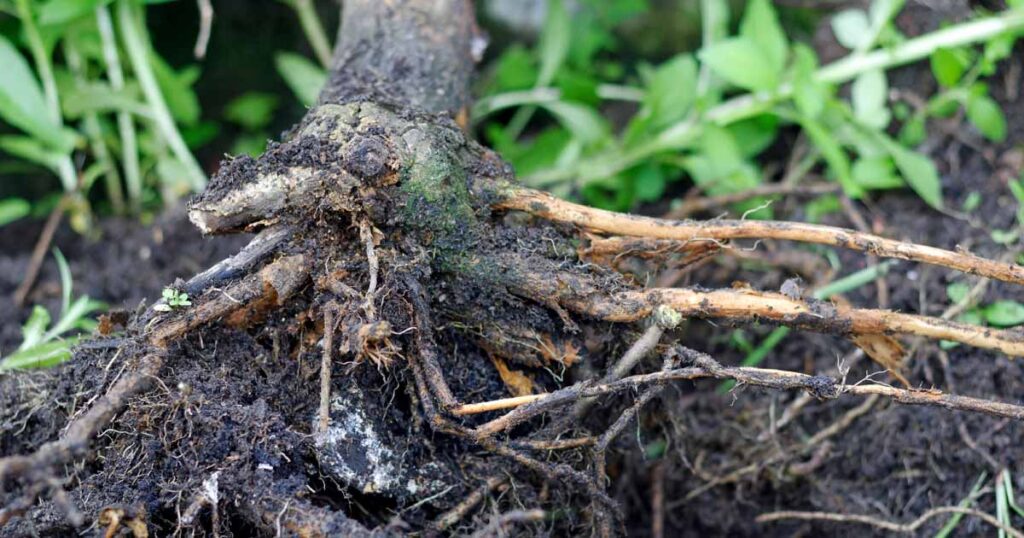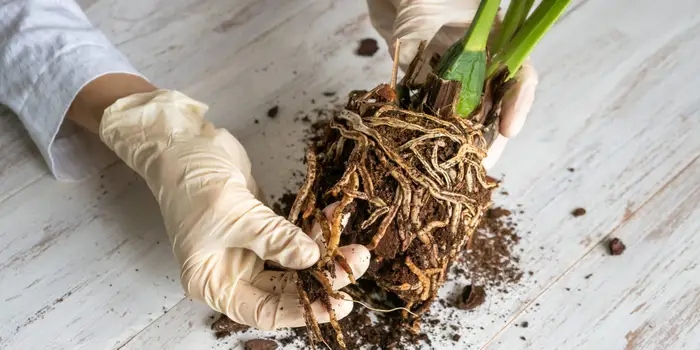Root rot is a serious and potentially devastating condition that affects the roots of various tree species. Different pathogens, including species of Phytophthora, Armillaria, and Rhizoctonia, among others cause this fungal disease. This comprehensive guide delves into the causes, symptoms, and effective root rot treatment in trees.
Wanna learn more about plant disease treatments, learn about powdery mildew treatment here.
Causes of Root Rot in Trees
One of those plant words that sounds awful is root rot. Although it’s something to avoid, it may frequently be resolved. Preventing root rot is preferable to treating it.
Root rot in trees is a complex condition driven by various factors, primarily fungal pathogens that compromise the root system’s integrity. Understanding these causes is crucial for developing effective treatment strategies.
Fungal Pathogens
Fungi such as Phytophthora, Armillaria, and Rhizoctonia are major contributors to root rot. These pathogens invade the root system, initiating a process of decay that can be detrimental to the tree’s health.
Soil Conditions
The environment in which a tree grows plays a pivotal role in root rot development. Poorly drained or waterlogged soil creates an ideal breeding ground for fungi. In such conditions, oxygen levels decrease, promoting the growth of root-rot-causing pathogens.
Overwatering
Excessive moisture around the roots is a common trigger for root rot. Overwatering can lead to waterlogged soil, reducing the amount of oxygen available to the roots. This creates a conducive environment for fungi to thrive and attack the roots.
Compromised Root System
A tree with a weakened or compromised root system is more susceptible to root rot. Wounds, injuries, or stress factors like drought can create entry points for fungal pathogens. Once inside, these pathogens compromise the structural integrity of the roots.
Recognizing Symptoms of Root Rot in Trees
Early identification of root rot symptoms is crucial for implementing timely and effective treatment. Recognizing these signs allows for proactive measures to preserve the tree’s health.

Discolored and Wilting Foliage
One of the most noticeable symptoms of root rot is a change in the tree’s foliage. Leaves may turn yellow or brown, and the tree may exhibit overall wilting. This is a result of the compromised root system’s inability to provide sufficient water and nutrients to the foliage.
Reduced Growth
Root rot negatively impacts the tree’s overall vigor, leading to stunted growth. A once-thriving tree may show signs of decline, with diminished branch length and fewer new leaves.
Cankers and Lesions
Inspect the trunk and branches for the presence of cankers or lesions. These are hollow areas that indicate the decay of the underlying wood. Cankers disrupt the normal flow of nutrients and water within the tree.
Root Inspection
A thorough examination of the root system is essential. Look for discoloration, a common indicator of fungal infection. Healthy roots are typically white, while infected roots may turn brown or black. Additionally, a foul odor may be present, signaling decay.
Leaf Drop
As root rot progresses, the tree may shed its leaves prematurely. This is a response to the diminished ability of the compromised roots to support the foliage. Leaf drop may occur out of season and is a clear indicator of root rot.
Diagnosing Root Rot in Trees
Diagnosing root rot is a critical step in effectively addressing this fungal disease. A thorough assessment involves a combination of visual inspection, soil analysis, root examination, and sometimes laboratory tests. Proper diagnosis is crucial for tailoring an appropriate and targeted treatment plan.
Visual Inspection
The first step in diagnosing root rot involves a visual examination of the tree. Look for external symptoms such as wilting foliage, leaf discoloration, and cankers on the trunk or branches. Additionally, inspect the overall health and growth patterns of the tree.
Soil Analysis
Conducting a comprehensive soil analysis is essential to understand the conditions contributing to root rot. Focus on soil drainage and moisture levels. Poorly drained or waterlogged soil creates an environment conducive to fungal growth. Analyzing soil texture and structure helps in determining if corrective measures are needed.
Root Examination
A careful examination of the root system provides valuable insights into the extent of root rot. Gently excavate the soil around the base of the tree to expose the roots. Look for discoloration, decay, or a foul odor. Healthy roots are typically white, while infected roots may exhibit a brown or black coloration.
Laboratory Tests
In some cases, laboratory tests may be necessary to identify the specific fungus causing root rot. This is particularly relevant when visual symptoms alone are insufficient for accurate diagnosis. Lab tests can help determine the most effective treatment options based on the identified pathogen.
Effective Root Rot Treatment
Once root rot is diagnosed, implementing an effective treatment plan becomes crucial to halt the progression of the disease and promote the tree’s recovery. A holistic approach that addresses the underlying causes and supports the tree’s overall health is key.
Improving Soil Drainage
Enhancing soil drainage is a fundamental step in preventing the recurrence of root rot. Correcting soil drainage issues helps create an environment less conducive to fungal growth. Implement measures such as installing drainage systems or amending soil structures to ensure proper water movement.
Aerating Soil
Introducing aeration methods can help improve oxygen levels around the root zone. Aerating the soil reduces compaction, allowing roots to access more oxygen. Increased oxygen availability inhibits the growth of anaerobic fungi responsible for root rot.

Pruning Affected Roots
Remove compromised or infected roots through careful pruning. This step is vital to prevent the spread of the fungus to healthy parts of the root system. Pruning also promotes the development of new, healthy roots.
Fungicide Application
Applying appropriate fungicides is an effective measure to control the spread of the root rot pathogen. Consult with arborists or horticulturists to select the right fungicide for the identified fungus. Systemic fungicides are often recommended as they are absorbed by the tree and distributed internally.
Stress Reduction
Reducing stress factors on the tree is crucial for its recovery. Optimize watering practices, ensuring a consistent but not excessive water supply. Avoid over-fertilization, and address any environmental stressors that may compromise the tree’s resilience.
Tree Rejuvenation Plan
Implementing a comprehensive plan to rejuvenate the tree is essential. This includes providing the tree with proper nutrition through fertilization, ensuring appropriate watering schedules, and ongoing monitoring to track the tree’s response to treatment.
Root Rot Treatment FAQs
What is the best treatment for root rot?
Treatment and prevention of root rot can be achieved using non-chemical techniques like replanting in newly prepared garden soil and enhancing soil drainage. Fungicides and other chemical control techniques can also aid in the removal of the disease-causing fungus spores.
Why is early identification of root rot symptoms important?
Early identification is crucial for effective treatment and preserving tree health. It allows timely intervention to address the causes and implement a tailored recovery plan.
Can a plant recover from root rot?
It’s too late to preserve the plant if the entire root system has already turned soft. Replanting the plant in fresh soil with adequate drainage will help restore its vitality if there are any healthy, white, firm roots present.
Conclusion
Root rot treatment demands a thorough understanding of its causes and symptoms for effective solutions. By adopting a holistic approach that addresses soil conditions, promotes drainage, and involves targeted treatments, arborists and tree owners can enhance the chances of a tree’s recovery and long-term health.


